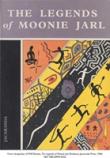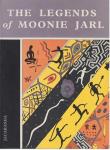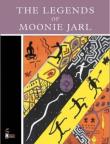AustLit
Latest Issues
AbstractHistoryArchive Description
'The Legends of Moonie Jarl is a collection of twelve traditional stories of the Butchulla/Badtjala people from Fraser Island and the adjacent mainland around Hervey Bay in Queensland. The Moonie Jarl of the title refers to the Butchulla/Badtjala elder responsible for passing traditional knowledge through generations of those people. Each story in this collection is incorporated into one of nine story-maps, supported by explanatory keys opposite each full-page illustration.' (Source: Juilet O'Conor, 'The Legends of Moonie Jarl : Our First Indigenous Children's Book,' La Trobe Journal :79 (2007): 66-81.)
Notes
-
Australian Children's Books 1774-1972 and The Bibliography of Australian Literature Vol 2 have this book listed under 'Jarl, Moonie'. Further research indicates that the words Moonie Jarl (Teller of Tales) and Wandi (the wild duck) are the Aboriginal names of brother and sister, Wilf Reeves and Olga Miller (q.v.).
Contents
- The Flying Fox, Wilf Reeves , single work short story dreaming story (p. 8)
- The Yindingie, Olga Miller (illustrator), Wilf Reeves , single work short story dreaming story (p. 9-11)
- Yindingie and the Wallaby, Olga Miller (illustrator), Wilf Reeves , single work short story dreaming story (p. 12)
- Yindingie and the Catfish, Wilf Reeves , single work short story dreaming story (p. 13)
- The Boomerang, Olga Miller (illustrator), Wilf Reeves , single work short story dreaming story (p. 14-17)
- Minguin, Olga Miller (illustrator), Wilf Reeves , single work short story dreaming story (p. 18-21)
- The Fire Bird, Olga Miller (illustrator), Wilf Reeves , single work short story dreaming story (p. 22-24)
- The Storm Bird and the Swan, Olga Miller (illustrator), Wilf Reeves , single work short story dreaming story (p. 25-28)
- Mooging, Olga Miller (illustrator), Wilf Reeves , single work short story dreaming story (p. 29-33)
- Ornithorhynchus, Olga Miller (illustrator), Wilf Reeves , single work short story dreaming story (p. 34-37)
- The Wishing Crab, Olga Miller (illustrator), Wilf Reeves , single work short story dreaming story (p. 38-42)
- Your Own Jun Jaree, Wilf Reeves , single work short story dreaming story (p. 43-44)
Publication Details of Only Known VersionEarliest 2 Known Versions of
Works about this Work
-
Digital Curation, AustLit, and Australian Children's Literature
2019
single work
criticism
— Appears in: International Research in Children's Literature , July vol. 12 no. 1 2019; (p. 1-17)'This paper examines the effects of curatorial processes used to develop children's literature digital research projects in the bibliographic database AustLit. Through AustLit's emphasis on contextualising individual works within cultural, biographical, and critical spaces, Australia's literary history is comprehensively represented in a unique digital humanities space. Within AustLit is BlackWords, a project dedicated to recording Australia's Aboriginal and Torres Strait Islander storytelling, publishing, and literary cultural history, including children's and young adult texts. Children's literature has received significant attention in AustLit (and BlackWords) over the last decade through three projects that are documented in this paper. The curation of this data highlights the challenges in presenting ‘national’ literatures in countries where minority voices were (and perhaps continue to be) repressed and unseen. This paper employs a ‘resourceful reading’ approach – both close and distant reading methods – to trace the complex and ever-evolving definition of ‘Australian children's literature’.'
Source: EUP.
-
Legends Book Republished
2014
single work
review
— Appears in: Koori Mail , 19 November no. 589 2014; (p. 36) 'The Legends of Moonie Jarl, hailed as Australia's first Indigenous children's book, originally published in 1964, has been republished to celebrate the publication's 50th anniversary...' -
From Colonial Superstition to the Hairyman : Aboriginality and the Politics of Race
2010
single work
criticism
— Appears in: Papers : Explorations Into Children's Literature , vol. 20 no. 2 2010; (p. 11-22) 'The misconceptions of Indigenous incapacity and pastoral welfarism evident in the mid century texts are reversed by the end of the century and the texts that have made the same possible are discussed. Characterization of the Indigenous protagonists in each publication reveals much about changing perceptions of Aboriginality.' (Author's abstract)
-
A Life Work in Progess
2009
single work
column
— Appears in: The Australian , 10 November 2009; (p. 15) -
Aboriginal Children's Literature : More Than Just Pretty Pictures
2008
single work
criticism
— Appears in: Just Words? : Australian Authors Writing for Justice 2008; (p. 102-117) The BlackWords Essays 2015; (p. 7) The BlackWords Essays 2019;'This essay explores how some recent Aboriginal and Torres Strait Islander authored titles have used local languages and personal histories - including complex stories which deal with the Stolen Generations - to engage and educate young Australian readers, while providing much needed inspiration to nurture Indigenous audiences.' (Source: Heiss, Anita, Aboriginal Literature for Children: More Than Just Pretty Pictures, 2015)
-
Untitled
1965
single work
review
— Appears in: New Books for Boys and Girls , July no. 21 1965; (p. 14-15)
— Review of The Legends of Moonie Jarl 1964 selected work children's fiction -
The Legends of Moonie Jarl : Our First Indigenous Children's Book
2007
single work
criticism
— Appears in: The La Trobe Journal , Autumn no. 79 2007; (p. 66-81) 'This paper examines how cultural difference is portrayed in the first publication by Indigenous Australians in this genre. The path to the publication of this pivotal book ... reveals the successful employment of publishing opportunities empowering Indigenous Australians to change reader perception of the traditional story genre (p.67). -
Postcolonial Transformation and Traditional Australian Indigenous Story
2006
single work
criticism
— Appears in: Papers : Explorations into Children's Literature , December vol. 16 no. 2 2006; (p. 132-137) O'Conor examines and acknowledges the 1964 text The Legends of Moonie Jarl (Wilf Reeves) as a turning point in Australia's literary history and as a challenge to dominant colonial assumptions regarding Aboriginal culture. At a time when non-Indigenous representations of Aboriginality were privileged and presumed to be accurate, the twelve stories in this collection challenged the hegemonic view of the Indigenous population by 'defining the cultural significance of traditional Aboriginal culture' (134). In particular, O'Conor points to how the use of maps in the text works to 'invite readers across cultural boundaries' by using traditional symbols to develop the non-indigenous reader's understanding of Indigenous communities and as such, 'the story maps of The Legends of Moonie Jarl marked a new form of illustration in traditional narrative' (135). Her discussion focuses on how the text expands 'map reading' into the realm of cultural difference through its construction of a 'story map' that intergrates Indigenous and non-Indigenous signs and symbols. -
A Life Work in Progess
2009
single work
column
— Appears in: The Australian , 10 November 2009; (p. 15) -
From Colonial Superstition to the Hairyman : Aboriginality and the Politics of Race
2010
single work
criticism
— Appears in: Papers : Explorations Into Children's Literature , vol. 20 no. 2 2010; (p. 11-22) 'The misconceptions of Indigenous incapacity and pastoral welfarism evident in the mid century texts are reversed by the end of the century and the texts that have made the same possible are discussed. Characterization of the Indigenous protagonists in each publication reveals much about changing perceptions of Aboriginality.' (Author's abstract)
-
Legend from the Butchulla Tribe on Fraser Island: The Magic Power of The Spider Crab
The Wishing Crab
1992
single work
column
short story
— Appears in: Koori Mail , 29 January no. 18 1992; (p. 19)
- Fraser Island, Maryborough - Hervey Bay - Fraser Island area, Maryborough - Rockhampton area, Queensland,






